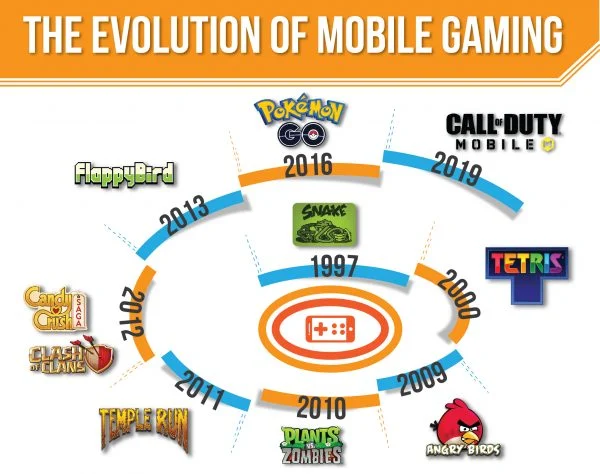The evolution of mobile gaming has been a remarkable journey, from simple pixelated games to immersive, high-definition experiences. As technology continues to advance, the question arises: What’s next for mobile gaming? The industry has come a long way, with the introduction of augmented reality, virtual reality, and cloud gaming, but there is still much anticipation for the future of this rapidly growing market. The next phase of mobile gaming is expected to bring even more innovation, interactivity, and connectivity to players around the world.
One of the most intriguing aspects of The Evolution of Mobile Gaming What’s Next is the potential for seamless integration with other forms of entertainment, such as movies, music, and social media. This could create a truly immersive and interconnected experience for players, blurring the lines between different forms of entertainment. Additionally, advancements in artificial intelligence and machine learning are expected to enhance the gaming experience, providing more personalized and adaptive gameplay for each individual. With the rise of 5G technology, we can also anticipate faster and more reliable connectivity, opening up new possibilities for multiplayer and online gaming experiences.
The Early Days of Mobile Gaming
In the early 2000s, mobile gaming was limited to simple games like Snake and Tetris that were pre-installed on mobile phones. These games were basic in graphics and gameplay, and the mobile gaming industry was still in its infancy. As mobile phone technology advanced, so did the capabilities of mobile games. With the introduction of smartphones, app stores, and touch screen interfaces, mobile gaming began to evolve into a more immersive and interactive experience.
Developers started creating more sophisticated games with better graphics, multiplayer capabilities, and in-app purchases. This shift in the mobile gaming landscape paved the way for the industry to grow rapidly and attract a wider audience, including casual gamers and hardcore gamers alike.
The Rise of Freemium and In-App Purchases
With the rise of smartphones, freemium games and in-app purchases became a dominant monetization model in the mobile gaming industry. Freemium games are free to download and play, but offer in-app purchases for virtual goods, extra lives, or special features. This model allowed game developers to reach a larger audience and generate revenue from a smaller percentage of paying users.
As a result, mobile games became more accessible to a global audience, and the industry saw a surge in revenue. The freemium model also sparked debates about the ethics of in-app purchases, especially in games targeted at children, leading to regulations and guidelines for developers to follow.
The Impact of Augmented Reality and Virtual Reality
Augmented reality (AR) and virtual reality (VR) have made their way into the mobile gaming world, offering players a more immersive and interactive gaming experience. AR technology overlays digital content onto the real world through the use of a smartphone’s camera, while VR technology creates a completely virtual environment for the player to interact with.
Games like Pokémon Go, which used AR to allow players to catch virtual creatures in the real world, became a global phenomenon. VR gaming, although more prevalent in console and PC gaming, has also started to make its mark in the mobile gaming industry with the development of VR headsets for smartphones.
The Dominance of Hyper-Casual Games
Hyper-casual games, known for their simple mechanics and gameplay, have become incredibly popular in the mobile gaming market. These games are easy to pick up and play, often requiring only a single finger to control the game, and they are designed for short, repeated play sessions.
The success of hyper-casual games can be attributed to their accessibility, addictive nature, and the ease of development for game studios. With minimalistic designs and straightforward gameplay, these games have captured the attention of a wide audience, making them a dominant force in the mobile gaming industry.
The Integration of Cloud Gaming
Cloud gaming has started to make its mark in the mobile gaming industry, allowing players to stream and play high-quality games directly from the cloud without the need for high-end hardware. This technology has the potential to change the way games are played on mobile devices, as it eliminates the need for large downloads and updates, and opens the door for more graphically intensive games on mobile platforms.
With the rise of 5G technology, cloud gaming is expected to become even more prevalent, offering seamless and low-latency gaming experiences on mobile devices. As more game streaming services enter the market, the integration of cloud gaming is likely to shape the future of mobile gaming.
The Role of Artificial Intelligence in Mobile Gaming
Artificial intelligence (AI) has been increasingly integrated into mobile games, enhancing the overall gaming experience. AI technology is being used to personalize gameplay, improve game mechanics, and create more realistic and challenging non-player characters (NPCs).
AI-powered chatbots and virtual assistants are also being utilized to provide players with real-time support and guidance within games. As AI continues to advance, it is expected to play a significant role in shaping the future of mobile gaming, offering more immersive and dynamic experiences for players.
The Influence of Social Gaming and Esports
Social gaming has become a significant aspect of mobile gaming, allowing players to connect, compete, and collaborate with friends and other gamers from around the world. With the integration of social features such as in-game chat, multiplayer modes, and social media sharing, mobile games have evolved into social platforms that foster community engagement and interaction.
Furthermore, the rise of mobile esports has transformed mobile gaming into a competitive and spectator-driven industry. Mobile esports tournaments and events have gained momentum, attracting a dedicated fan base and paving the way for professional mobile gamers to compete on a global stage.
The Future of Mobile Gaming: 5G, AR/VR, and Beyond
The future of mobile gaming looks promising, with advancements in technology such as 5G connectivity, augmented reality, and virtual reality shaping the next generation of mobile games. With the ability to support higher network speeds and lower latency, 5G technology will enable more seamless and immersive gaming experiences on mobile devices.
AR and VR are expected to continue playing a pivotal role in mobile gaming, blurring the lines between the digital and physical worlds. As these technologies become more accessible and sophisticated, they will open up new possibilities for innovative gameplay and storytelling in mobile games. Overall, the evolution of mobile gaming is set to continue as technology and consumer behaviors evolve, creating new opportunities for developers and redefining the gaming experience for players.
| Stage | Description |
|---|---|
| Early Mobile Games | Simple, low-graphic games like Snake and Tetris |
| Smartphone Era | Introduction of app stores, more complex games like Angry Birds and Candy Crush |
| Augmented Reality | Games like Pokemon Go that blend digital and real-world experiences |
| Virtual Reality | Immersive gaming experiences through VR headsets |
| Cloud Gaming | Streaming high-quality games to mobile devices without the need for powerful hardware |
SONUÇ
The Evolution of Mobile Gaming What’s Next konusu, mobil oyun endüstrisinin gelişimi ve gelecekteki potansiyel eğilimleri hakkında bilgi verir. Başlangıçta basit oyunlarla başlayan mobil oyunlar, daha karmaşık ve etkileşimli deneyimler sunmaya başlamıştır. Gelecekte, artırılmış gerçeklik, sanal gerçeklik, ve bulut tabanlı oyun teknolojilerinin mobil oyun endüstrisinde daha da yaygınlaşması beklenmektedir.



